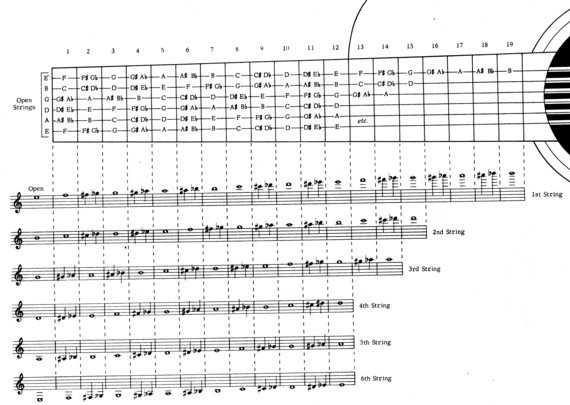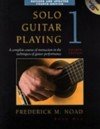The Guitar Fretboard
Familiarizing yourself with the guitar fretboard is important for any beginner classical guitarist. You will rarely be required, in the initial stages, to move outside of the first position on the guitar fretboard (the first three frets).
I’m getting a lot of messages from people coming here because they want to learn to play guitar as part of worship. If this is you, you might want to join Aaron Anastasi’s programme. Aaron is a musician and a worship leader. He put together a step by step programme for aspiring Christian musicians. If you're interested, you can use the exercises and advice in learn-classical-guitar-today to develop your finger strength and dexterity and Aaron's lessons to work on strumming and worship music.
CLICK HERE TO LEARN WORSHIP GUITAR !!
The first step is to become familiar with notes in the first position of the guitar fretboard. Provided on the diagram below are the notes in the first position of the fretboard (includes frets 1, 2 and 3), notes in the second position of the fretboard (includes frets 2, 3 and 4) and notes in the third position in of the guitar fretboard (includes frets 3, 4 and 5).

The names of the notes at the open strings, in standard tuning are tuned to the notes E, A, G, B and E going from the lowest string (6th string) to the highest string (1st string). The 6th string is generally called the lowest string or the bottom E (even though it is on top of the other strings) because the sound that it makes is lower than the E on the 1st string which (even though it is at the bottom of all the strings) is called the top E.
Later you will include the second position and thereafter all other positions. The complete notes of the guitar can be found in Frederick Noad, Solo Guitar Playing which is reproduced in full in the diagram below.
Frederick Noad's, Solo Guitar Playing is one of the best books for a beginner guitarist to buy and I would absolutely recommend that you get a copy. In fact, I generally use this book almost exclusively for the first 3 to 6 months of my lessons with students.
If you don't have a teacher, Frederick Noad's, Solo Guitar Playing is definitely the book to help you through the beginner stages.

Guitar Basics
Buying a Classical Guitar: If you need to buy a guitar or are thinking about buying a new guitar, then this page is for you. It provides useful tips on how to pick your first classical guitar.
Sitting Positions: This lesson takes you through the principles and dos and donts of the classical guitar sitting position. It introduces you to the guitar supports available including footstools, the Efel, the Dynarette, the A-Frame and the ErgoPlayay.
Music Theory: Music Theory provides an introduction to musical notation and to the basic theory that you will need to start playing.
Finger Names : Finger names in classical guitar scores.
How to Tune your Guitar: How to tune your guitar. There is nothing worse than playing on an untuned guitar. This page teaches you how to tune your guitar with and without an electronic tuner.
Guitar Parts: Start by becoming familiar with the parts of the guitar so that you know what we're talking about when we talk about the bridge or the fret.

You'll need to go a little deeper into music theory as you proceed. The best online resource for this is Guitar Theory Revolution. It recognises that music theory is very hard for guitarists because music theory has till now been located in the piano paradigm. The Guitar Theory Revolution overthrows the piano paradigm that is holding you back and embraces the attributes of the guitar to unpack music theory. In fact, it goes further and allows you to see that the guitar is one of the best instruments for learning theory.






